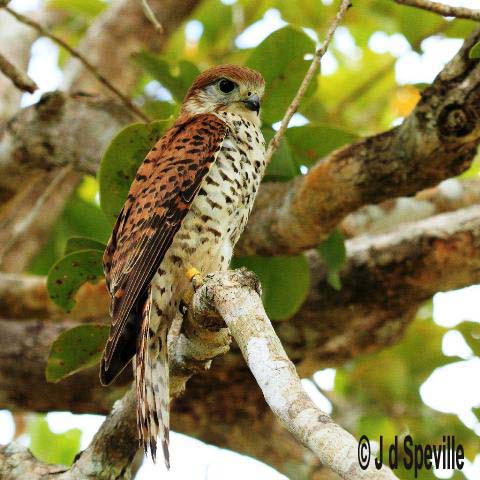 Mauritius Kestrel Falco punctatus Mauritius Kestrel Falco punctatus
IUCN status: Endangered in 1994, downlisted to Vulnerable in 2000.
|

Female Kestrel
|
Fast facts
- a medium-sized kestrel, easily identified by its creamy white chest with dark markings, and the chestnut brown head, neck and wing feathers also with black markings
- the only bird of prey remaining in Mauritius
- females are usually slightly bigger than males
- their diet consists of geckos, agamid lizards and small birds
- known in French as crécerelle
- approximately 20-26cm in length
|
|
|
|
|
The Mauritius Kestrel was once regarded as the world’s rarest bird; by 1974 only four individuals were known to exist in the wild. This raptor was probably once common across Mauritius from sea level to the highest upland forest. With the destruction and degradation of native forest for lumber and clearing for agriculture the numbers declined dramatically. By 1900 kestrels had became restricted to just three areas: the Bambous Mountains of the east coast, the Moka Mountains in the north, and the Black River Gorges area in the south-west, with possibly several hundred pairs remaining. The use of organo-chloride and organo-phosphate pesticides (mainly DDT) in the 1950s and 1960s, for the control of malaria-carrying mosquitoes, was almost the nail in the coffin for this species. DDT absorbed by the kestrels through their prey caused the shell of their eggs to become thin and then break beneath the incubating females. By the late 1950s only 20 to 25 birds could be found, all in the Black River Gorges, where pesticides had not been used. By May of 1974, the total wild population was reduced to a mere four birds, including a single breeding female, and the future survival of this species looked unlikely.
However, intensive conservation efforts have increased the population to around 400 individuals: one of the greatest success stories in species recovery programmes. The programme involved a combination of the intensive management of the wild population, captive rearing of rescued eggs as well as captive breeding for release into the wild.
To maximize breeding success in the wild population some kestrels were supplementary fed and nest sites were protected from another problem for kestrels – introduced mammalian predators, including rats, monkeys and mongoose. Predator-proof nest boxes were provided and are still used by kestrels today. By 1991 there were at least 30 wild nesting pairs and a population of 170 wild birds in three sub-populations. By 1994 some 346 young kestrels had been released back into the wild and the total population at the end of the 1990s was thought to be between 600 and 800 birds.
The success of the project resulted in the Mauritius Kestrel being downgraded by the IUCN from Critically Endangered to Endangered in 1994, and then to Vulnerable in 2000 .
Over time the small population re-introduced to the Moka Range in the 1990s died out, leaving the population in the Black River Gorges, which has suffered a slight range contraction, and the Bambous Mountains population, together comprising around 400–500 kestrels today.
With the significant recovery of the Mauritius Kestrel there was no longer a need to intensively manage the populations. The detailed monitoring of the west coast population was discontinued in 2002, although monitoring of the Bambous Mountains population has continued to this day, with almost all nests found and nestlings ringed each season. This long-term data set is unusually complete for a wild animal and is now being used in various PhD studies. Up to 75% of the east coast birds breed in our nest boxes, which makes it easier to access and monitor them.
In 2007, after a six-year hiatus, the monitoring of the west coast population in the Black River Gorges was recommenced due to anecdotal evidence that the population size was declining. Because of the more difficult terrain and the habit of around 85% of these kestrels of breeding in natural nest sites (cliff and tree cavities), access is difficult and our monitoring and collection of data is not as comprehensive as for the east coast. Although we have established that there has been a decrease in the west coast kestrel's range, breeding productivity remains good.
The Mauritius Kestrel recovery programme is the most spectacular of any raptor conservation programme in the world.
Click here to watch the video namely "A brief introduction of the Mauritius Kestrel" directed by O'Brian Clarisse highlighting the activities for the Kestrel Project. |
|